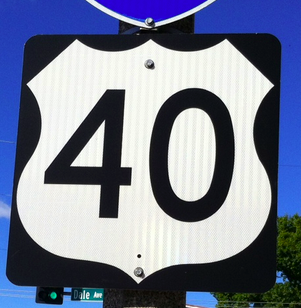Stories of Black residential displacement in St. Louis County are not hard to come by. Meacham Park. Brentwood Promenade. Downtown Clayton. One of these stories—the one still playing out here in Maplewood—is a little harder to place a label on, but in the end, its outcome may be no less drastic.
Today, the U.S. Census Bureau estimates Maplewood’s Black population to be around 11%. That’s less than the U.S. percentage (around 14%) and far less than the percentage in St. Louis County (around 25%) and St. Louis City (around 44%). Anyone familiar with the long-standing state of racial segregation in the St. Louis area may not be too surprised by this. As a predominately white mid-county municipality, Maplewood stands firmly on one side of the “Delmar Divide.” But what’s crucial is that Maplewood, of course, is quite unique among its mid-county neighbors, particularly in its history of racial and socioeconomic diversity. Yet Maplewood’s Black population today is the lowest it has been in decades—and perhaps ever.
What many people love about Maplewood is its distinct mix of urban characteristics. Maplewood is smaller and more compact than Webster Groves, less commercially developed than Brentwood, and more centrally located than Kirkwood. Relatedly, Maplewood has a long reputation for being less affluent than these same county neighbors—and less white, too. According to the U.S. Census, Maplewood has a far lower percentage of white residents (and far higher percentage of Black residents) than Webster, Brentwood, or Kirkwood. Most would agree this diversity is yet another of Maplewood’s unique and beloved qualities.
But if Maplewood thrives off diversity, what are we risking by losing it? Because, when it comes to Maplewood’s largest racial minority, we definitely are. In 1990, according to the U.S. Census, Maplewood had a Black population of around 14% and a white population of around 83%. Over the course of the next two decades, Maplewood’s Black population stayed about the same while the white population decreased drastically. White disinvestment resulted in a large overall population loss and significant decrease in the percent of white residents. The comparatively stable Black population increased during this period, resulting in the percent of Black residents in Maplewood increasing to around 19%, making Maplewood one of the most racially integrated mid-county municipalities in 2010.*
But the decade that follows tells a very different story.
The 2020 census revealed a widespread Black exodus out of the St. Louis area, which experts largely attributed to a lack of investment, safety, and opportunity in predominantly Black neighborhoods. Communities experiencing the highest rates of disinvestment tended to see the greatest decline among Black residents. Maplewood, however, saw a great increase of investment and economic growth in the years from 2010 to 2020, suggesting we would have avoided the high rate of Black departure seen elsewhere. In fact, St. Louis County as a whole did just that. While the Black population has plummeted in the city, the county at large has seen an increase in Black residents. Outside north county, there are only two places that saw a sharp reversal of the county’s overall gain. One is our closest neighbor of all, the city of Richmond Heights. The other is Maplewood.
Both cities saw a notable drop in their Black populations, unlike other municipalities nearby. So what happened here between 2010 and 2020 and in the years since? Well, it’s so well-known that it hardly needs to be said. Maplewood’s decade of “success” is largely attributable to three factors—strong investment in the school district, an appealing central urban location, and crucially, a stock of moderately priced single-family homes that middle-class families could snatch up at inflated rates. Maplewood became a great deal for families with extra money to spend—and quickly a “destination” neighborhood with skyrocketing housing costs and a long list of middle- and upper-class families waiting to pay them.
At the same time, the City of Maplewood settled two high-profile lawsuits centering around hostile anti-black and anti-poor discriminatory practices. As property owners benefited from rising property values, tenants faced increasingly high rents and rates of food and housing insecurity. Instead of helping low-income renters, the city used tax dollars to subsidize new luxury apartments and attract still more wealthy residents. To make room for Maplewood Commons in the early 2000s, a low-income neighborhood was displaced, using eminent domain when the city deemed it necessary. And instead of supporting its Black leaders trying to make a difference, the community recently launched an all-out campaign to bring them down.
Gentrification is not a natural process, but it is a predictable one, particularly when struggling cities, in a rush to stabilize, neglect some of their most important values. The ultimate outcome? While wealthier white residents enjoy the social benefits of improved schools and economic growth, fewer and fewer Black residents are able to afford such luxury.
Fortunately, Maplewood can still change this story—and now is the time. We have already taken good steps: attaching development incentives to affordable housing, setting eviction and housing voucher protections, and codifying a tenant bill of rights.
What else can we do? We can continue to value people before property and inclusion before financial gain, and we can reflect these values in equity-focused city policy. We can listen to and support Black community leaders. We can take steps to stop further displacement and ensure Maplewood is affordable for Black families who may want to move here. And we can acknowledge that without deliberate changes like these, by the end of this decade, Maplewood may be less diverse than ever—and far poorer for it.
*Note: This 2010 statistic is slightly lower, at around 17.2%, when counting only for the population identifying as “Black alone.” When counting for the population identifying as both Black alone and Black in combination with some other race(s), the number increases to 19.2%. From 2010 to 2020, the “Black alone” percentage decreased by about 4%, while the overall Black percentage decreased by 3.2%. Today’s census estimate of 11% is for Black alone; the number for Black alone and in combination is likely higher. Other U.S. Census data, though less precise than the decennial census, supports the current decline of Black residents in Maplewood alongside an increase in white residents and relative stability among other racial and ethnic groups.


I was raised in Ferguson on the Corner of Dade Ave. And Airport Rd. two and a half blocks from Kinloch, MO it was very sad for me as a child seeing how humans could be expected to live in deplorable conditions is what I wittiness. This was mid-1950s until now. Much of Kinloch now has new warehousing to support aircraft freight. Multi-million dollar buildings. But no low-income housing. Some subsidised apartments. Black residential displacement in St. Louis County is not hard to come by.
@Collin, I don’t know you, but I suspect you have no ill-intent. I just think you need to be careful speaking for minority groups that you do not belong. I encourage you to research “white savior complex’” and reflect on your various posts to 40south.
Yep, basically his daddy issues coming out.
tone deaf as most of that crew is Helped Knapper lose the election.
Helped Knapper lose the election.
Please …weekly I see some of our neighbors who reside in some of our affordable housing units. Many are moving from our area due to the fact that owners have hired managers who ignore the requested and needed repairs to keep these units up to a minimal basic livable standard. Many of these residents feel the need to move to safe places to live outside of our area. Please let us consider helping retain our diverse citizenry by keeping a much closer eye on the actions of the owners and managers of the affordable housing units already in our area.
Hi, Colin! Well university training suits us well most of the time but numbers never have been very friendly here in Maplewood. Like Richmond Heights and Brentwood, very few make for a lot as percentages go. I know my family didn’t help with diversity statistics but kids grow up, etc. I wouldn’t take our recent elections in this direction at all. Folks make misteps in public service, nothing to do with your data, and accountability arrives at the ballot box. The big picture is hard to see on a tiny dot in the middle of a large target in our area without wavering back and forth quite a bit. However, the Maplewood United Methodist Church just gained an excellent, long experienced pastor MUCH due to its attitudes of inclusion and community service (non evangelistic). The church has a reputation statewide. The academic summer school experience there, as we speak, is quite diverse even beyond our African American neighbors. (For instance, I now have two Asian families within one house of mine in central Maplewood) SO, perhaps the glass is half full as much as half empty?
I’ve always appreciated your dedication, values, and enthusiasm, Colin. Glad we are neighbors!
Thank you for providing your thoughtful observations, Colin. The story our city and our region is complex and sticky. I have learned that living our stated values and supporting our marginalized neighbors is difficult and requires intentional work. I am glad you continue to bring your voice to this space.
I propose that Collin move his gentrifying family to another municipality, so as to satisfy his eugenicists’s obsession with racial statistics and categorization. However where would this other municipality be located? Wherever they would choose to colonize next would have its diversity diluted! A conundrum of the first order which cannot be blogged its way out of. Perhaps a solution would be to create a sort of reservation for the wypipo who wish to contribute to the improvement of census data and witness eachothers whiteness on the daily. It could be unincorporated, thus the long white shadow they cast would not contribute to any other town’s statistics. There is some vacant land in Bridgeton that stays warm all year thanks to its glowing radioactive underground trash fire. Maybe there?
LOL-the same crowd who LITERALLY moved here for the school district, housing, etc. is now crying “OMG WHAT HAVE Y’ALL DONE TO THIS LITTLE TOWN?! I vote they all pack up and plant roots elsewhere and create their own little Utopia.
Thank GOD that Colin is back to splain everything to all of is–what ever would we do without him and his “sage” wisdom? I am sure that private property owners will read this and think “Dang it. I need to LOWER rent for strangers to keep this town diverse!”
News flash–our local small businesses are struggling, Colin. Some are likely going to go under very soon without a lifeline–but by all means, let’s pour our energies into this. Funny how you never seem to acknowledge the critical role that business/commerce plays in the survival of ANY area like this.
It’s almost as if you didn’t see or understand the results of the most recent election here.